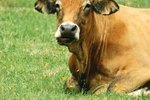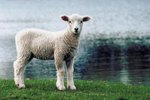Jersey cows are primarily a dairy breed, and while the females can serve as dairy cows when grown, that's obviously not the case with male calves. While a small percentage are kept as bulls, most end up as veal calves or steers. The latter are generally fattened up and slaughtered at approximately 1 year of age.
Jerseys
One of the world's oldest cattle breeds, the Jersey hails from Britain's Isle of Jersey. The first stock arrived in the United States in the 1850s. Among the highest milk producers in both volume and quality, the Jersey is also among the most feed-efficient. That last quality is important for steers fattened for meat. Jerseys also mature earlier than other breeds of cattle.
Jersey Steers
Steers are young castrated male cattle. While a large milk production capability paired with relatively small size is a plus for Jersey cows, small size in the steers is a negative for producing beef. While Jersey bulls have a reputation for being difficult and dangerous, much of that is due to testosterone, so steers may be more tractable. While most Jerseys are a golden brown, colors range from light gray to a dark brown that's almost black.
Market Share
According to Oregon State University, dairy breeds make up approximately 18 to 20 percent of all cattle marketed in the United States for beef production. Of those, the majority are Holstein cattle, with Jerseys, Brown Swiss and Guernseys making up almost all the other dairy cows used to produce beef. OSU states that Jersey steer calves "are of little to no value to most dairy and beef operations." Besides a small market for veal calves, Jersey steers might end up in 4-H or other youth agricultural programs, but many are euthanized not long after birth.
Oxen
If you've got a Jersey steer calf and don't want to send him to market, he can be more than just a pet. You can turn that steer into an ox—which simply means that he's been trained to work, usually as a draft animal. If you live in an area where Jersey dairy farms are plentiful, you might be able to obtain two young male calves relatively cheaply to start your team. Look for two calves of similar size and coloring. Because oxen need horns to hold the yoke on while they're pulling downhill, don't consider "polled" Jersey calves, those without horns. Some Jerseys are born naturally polled, while others have their horns removed while still very young.
References
- Oklahoma State University: Jersey
- American Jersey Cattle Association: Why Jerseys? [PDF]
- Oregon State University: Growth and Carcass Merit of Purebred Jersey Steer Calves Finished on Grain-Based Diets at Two Different Energy Levels [PDF]
- Woodside Creamery: Jersey Cow Facts
- Rural Heritage: Selecting Oxen
- Ag Web: Igenity Horned/Polled Analysis Now Available for Jersey Breed
Writer Bio
Jane Meggitt has been a writer for more than 20 years. In addition to reporting for a major newspaper chain, she has been published in "Horse News," "Suburban Classic," "Hoof Beats," "Equine Journal" and other publications. She has a Bachelor of Arts in English from New York University and an Associate of Arts from the American Academy of Dramatics Arts, New York City.



